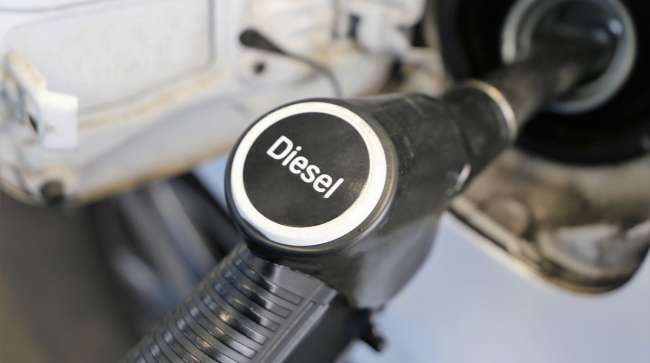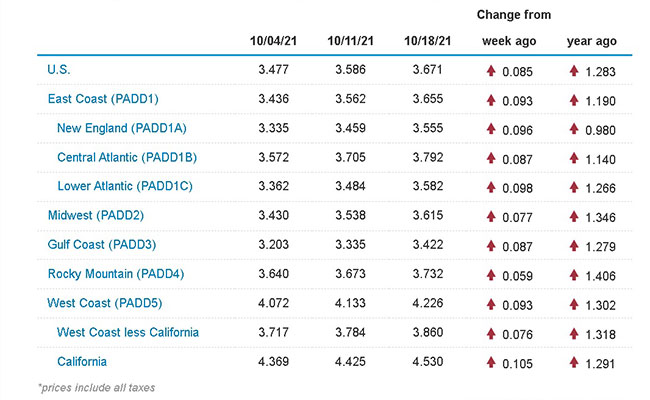Senior Reporter
Diesel Spikes 8.5¢ to $3.671 a Gallon

[Stay on top of transportation news: Get TTNews in your inbox.]
The national average price of diesel continued to surge, spiking 8.5 cents to $3.671 a gallon, according to Energy Information Administration data released Oct. 18.
With that increase, diesel’s price has climbed 19.4 cents a gallon in the past two weeks and 26.5 cents in the past three. A gallon now costs $1.283 more than it did at this time in 2020.
The last time diesel cost at least as much as its current price was Nov. 10, 2014, when it was $3.677.
U.S. On-Highway Diesel Fuel Prices

EIA.gov
Average cost for a gallon of diesel rose in all 10 regions in EIA’s weekly survey, with the largest being 10.5 cents in California and smallest being 5.9 cents in the Rocky Mountain region.
Gasoline also saw a significant jump, with an increase of 5.5 cents per gallon to reach $3.322. That’s $1.172 more than a year ago.
Demand for diesel is set to surge to its highest since 2018 next year as truckers continue to clear a backlog of deliveries accumulated during the pandemic, according to an EIA report.
EIA predicts diesel consumption, which already has surpassed its 2019 level, will rise an additional 3% to 4.11 million barrels a day next year.
Over the past four weeks ending Oct. 15, distillate fuel product supplied averaged 4.1 million barrels a day, up 8.3% compared with the same period last year. Motor gasoline product supplied averaged 9.4 million barrels a day, up 9.8% compared with the 2020 period, EIA reported.
Product supplied is considered a marker for demand.
U.S. average on-highway #diesel fuel price on October 18, 2021 was $3.671/gal, UP 8.5¢/gallon from 10/11/21, UP $1.283/gallon from year ago https://t.co/8Vh0yGST0W #truckers #shippers #fuelprices pic.twitter.com/zk6G6lDyDD — EIA (@EIAgov) October 19, 2021
The expected increase in 2022 is an indicator that the supply chain crisis rocking companies from Apple Inc. to Toyota Motor Corp. could last well into next year, according to Bloomberg News. Around the California ports of Los Angeles and Long Beach, a gateway for imports of goods from Asia, there’s a backlog of around 100 containerships waiting to discharge cargo ranging from computers to gardening equipment.
Ihsan Abdul Jabbar, oil minister of OPEC’s second-largest producer, and Russia’s President Vladimir Putin both said earlier in October it is possible crude oil prices will hit $100, while the boss of trading giant Mercuria Energy Group Ltd. said prices could reach that level this winter. The talk comes as global oil inventories continue to decline, with analysts forecasting stock draws of about a million barrels a day in the fourth quarter.
West Texas Intermediate crude oil, the industry benchmark, traded on the New York Mercantile Exchange at $83.91 midday Oct. 20 and closed at $82.80. That was up from a close of $80.56 on Oct. 13.
Higher prices for crude oil translate into higher prices for diesel fuel.
Winter is coming: We forecast that avg U.S. household spending for home #heating #fuels will increase due to higher expected fuel costs as well as more consumption of energy as a result of colder temps https://t.co/vhRNAjwyuQ #natgas #STEO #electricity #propane #heatingoil pic.twitter.com/JFqmJLHNXA — EIA (@EIAgov) October 20, 2021
Meanwhile, October snowstorms in the west and Rocky Mountain announced winter’s coming.
One trucking expert offered tips on winter operability and diesel fuel.
“Be consistent in your use of a fuel supplier(s) throughout the season to make sure that you are getting the right formulation of deicer/stabilizer additives for your operating environment that are used throughout the cold season, not just when temperatures are extreme,” Jack Legler, technical director of American Trucking Associations’ Technology & Maintenance Council, told Transport Topics.
“Water is not your cold-weather friend; make sure there is none in your system, your trucks as well as on-site storage,” he added.

Legler
Legler provided other tips:
• Change filters early in the season to reduce the chances of clogging due to ice or wax.
• Be careful not to fuel up immediately after fuel is delivered into storage tanks to reduce introduction of moisture or contamination.
• Be sure that fuel system heaters are functioning at their optimum and keep them in good repair.
• Keep tanks full overnight when there are significant swings in temperature and drain fuel/water separators frequently to reduce the chances of ice formation.
• Be careful if fueling in a warm climate immediately before a trip into a cold one. The fuel may not be formulated for harsh winter conditions.
• Make sure whoever is selling you fuel is paying attention to these factors as well.
Legler said, “My usual advice is go to TMC RP [recommended practice] 341A, Diesel Additive Functionality Groups & Winter Operability Guidelines; RP 356A, Cold Flow Operability of Diesel Fuel; and RP 357A, Biodiesel Blended Fuels. They are an excellent set of resources for understanding diesel fuel additives and winter operability.”
Want more news? Listen to today's daily briefing below or go here for more info:


